|
|
Inspired and dedicated as per personal communication with Beth McCoy, Eumorpha achemon, Billings, August 15, 2011
Updated as per James P. Tuttle's The Hawk Moths of North America, August 15, 2009
Updated as per BAMONA, August 15, 2011
Updated as per personal communication with Spencer Brown, Billings, Montana Eumorpha achemon in flower bed, August 10, 2018
|
Yellowstone County, Montana, and Other South Eastern Counties
Bighorn, Musselshell, Treasure, Rosebud, Carbon, Golden Valley, Stillwater
Sphingidae Larvae
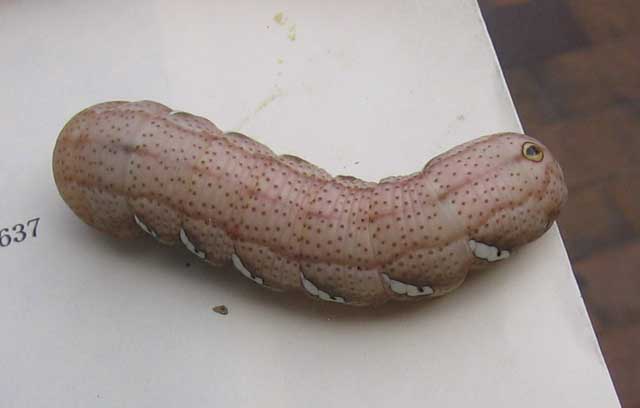
Eumorpha achemon fifth instar, Billings, Yellowstone County, Montana,
August 15, 2011, courtesy of Beth McCoy.
This page is inspired by and dedicated to Beth McCoy. Beth sends the image of the Eumorpha achemon larva at top of page. She writes,
"Hi there!
"I found this on my brick patio this afternoon. The temperature at the time was about 90 F out there. I live in Billings, Montana, and I have seen large green
caterpillars this size, but never one with this flesh color. It was about four inches long, bigger around than my thumb, and very heavy. The bottom had little
"suction cups", like an octopus. It didn't move fast, but steadily and smoothly over the lawn where I put it and then across the hot cement driveway. I spend a
lot of time outdoors, and have never seen anything like this one. Thanks!!"
I reply,
"Hi Beth,
It is an Eumorpha achemon larva, of the Achemon Sphinx Moth.
"I request permission to post image, credited to you, to a Yellowstone County thumbnail checklist that I will create??
It is ready to pupate. Here is a page you can use until I get the Yellowstone page created.
http://www.silkmoths.bizland.com/Sphinx/njCamdensphlar.htm
"That species is not often found in Montana."
For care of "found larvae/caterpillars" visit Manduca sexta larva, central Texas,
August 21, 2008, Trina Woodall.
Many thanks to Spencer Brown who sends the following image.
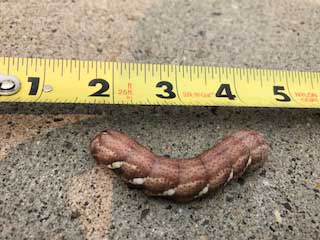
Eumorpha achemon final instar, Billings, Yellowstone County, Montana,
August 19, 2018, courtesy of Spencer Brown.
Twelve Sphingidae species are listed for Montana on the BAMONA website. Not all of the species are reported or anticipated in
Yellowstone County (Four are reported on BAMONA as of August 15, 2011; seven are reported as of August 19, 2018).
It is hoped that this checklist, with the thumbnails and notes, will help you quickly identify the larvae you are likely to encounter.
A "WO" after the species name indicates that I have no confirmed reports of this species in your county, but I
(William Oehlke) expect that this moth with its larvae are present or might be present.
A "BAMONA" indicates the moth is reported in Lepidoptera of North America,
#1. Distribution of Silkmoths (Saturniidae) and Hawkmoths (Sphingidae) of Eastern North America,
an excellent little booklet available through Paul Opler.
Please help me develop this list with improved, documented accuracy by sending sightings (species, date, location), preferably with an
electronic image, via email to Bill Oehlke.
Please also report your sighting to BAMONA, an excellent online resource, via the links to the left or in the header.
Although this page was originally created for Yellowstone County (7): Sphinx vashti; Pachysphinx modesta; Smerinthus cerisyi; Paonias myops;
Eumorpha achemon; Hyles euphorbiae; Hyles lineata, it also serves as an accurate checklist for nearby counties in south eastern Montana:
Bighorn (0);
Treasure (0);
Rosebud (2): Eumorpha achemon; Proserpinus juanita.
Musselshell (0);
Golden valley (0);
Still Water (1): Sphinx vashti.
Carbon (8): Sphinx vashti; Paonias excaecata; Paonias myops; Smerinthus jamaicensis; Smerinthus cerisyi; Hemaris thetis; Hyles euphorbiae;
Hyles lineata.
Sphinginae subfamily
Sphingini tribe:
 |
Larvae hide in the day and feed primarily on cherry, plum, and apple
at night. Larvae have been found on Amelanchier nantuckensis
in Massachusetts and have been reared to pupation in Michigan on
Prunus serotina. Note purple oblique lines.
|
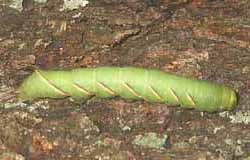 |
Sphinx luscitiosa
WO,
the Canadian Sphinx or
Clemen's Sphinx
Larval hosts are willow
(Salix), poplar (Populus), birch (Betula),
apple (Malus), ash (Fraxinus), waxmyrtle
(Morella), and northern bayberry.
|
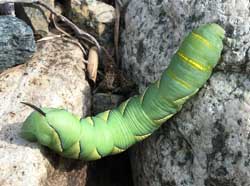 |
Sphinx vashti
Yellowstone/Carbon/Still Water,
the Snowberry Sphinx
Larvae feed on the common snowberry (Symphoricarpos albus)
and on coralberry (S. orbiculatus). Note the two golden
lines of slightly raised bumps, one just behind the head, the other
on the thorax.
|
Smerinthini Tribe:
 |
Pachysphinx modesta
Yellowstone,
the Modest Sphinx or Poplar Sphinx
Larvae feed on poplars and cottonwood.
The anal horn is greatly reduced in the final instar.
|
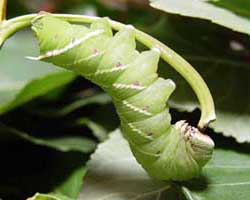 |
Larvae feed on cottonwood and poplar (Populus) and willow
(Salix).
Larvae are very chunky with little to distinguish them
from Pachysphinx modesta.
|
 |
Larvae accept willows, birches, and cherries.
I have also found them in the wild on oak in eastern Canada.
Skin is quite granulous.
|
 |
Paonias myops
Yellowstone//Carbon, the Small-eyed Sphinx
Wild cherry species are the favorites as larval foodplants, but eggs
will also be deposited on birches and other forest trees.
There are varying degrees in the amount of red markings along the sides.
|
 |
Smerinthus cerisyi
Yellowstone/Carbon,
Cerisy's Sphinx;
Cerisyi larvae greatly resemble modesta larvae, both being pale
green, with granular skin, pale lateral diagonal lines, faint red
spiracular circles, and very pale longitudinal lines running from the
head to a more pronounced anal diagonal line.
Larvae have green heads bounded dorsally with a pale yellow
inverted "V".
|
 |
Smerinthus jamaicensis Carbon, Twin-spotted Sphinx:
Larvae feed upon many forest trees including birches and cherries, but are expecially fond of poplars and willows. Red markings on sides
vary greatly from specimen to specimen. Usually in more northerly counties. |
Macroglossinae subfamily
Dilophonotini tribe:
 |
Hemaris diffinis
WO??, the
Snowberry Clearwing or Bumblebee Moth
Larval host plants include Snowberry (Symphoricarpos),
honeysuckle (Lonicera), Coralberry, viburnums, Blue Dogbane
(Apocynum) and dwarf bush honeysuckle (Diervilla lonicera).
Horn is black with a yellow base.
|
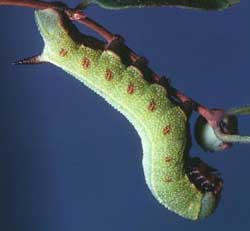 |
Larval host plants include Snowberry (Symphoricarpos),
honeysuckle (Lonicera), Coralberry, viburnums, high bush cranberry and hawthorn (Crataegus).
Horn is black with a slightly lighter base. This western species was formerly classified as
H. diffinis or H. senta. Those species west of the Continental Divide are now classified as
H. thetis.
|
Philampelini tribe:
 |
Eumorpha achemon
BM/SB/Yellowstone/Rosebud,
the Achemon Sphinx
Larvae feed upon Grape (Vitis), Virginia Creeper (Parthenocissus quinquefolia) and other vines and ivies (Ampelopsis).
Larvae occur in both a light (green) form and a darker (tan/brown)
form. Note six "segmented" oblique lines.
|
Eumorpha achemon mature larva, August 15, 2011, Beth McCoy
Eumorpha achemon mature larva, August 19, 2018, Spencer Brown
Macroglossini tribe:
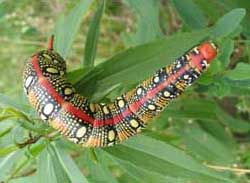 |
Hyles euphorbiae Yellowstone/Carbon,
Leafy Spurge Hawk Moth
Larvae feed on leafy spurge. Larvae are also conspicuously colored, with a
pronounced tail or "horn" near rear end.
Young larvae are variously patterned with green, yellow, and black;
older larvae have distinctive red, black, yellow, and white color
pattern. Mature larvae may approach 10 cm in length; when disturbed,
they regurgitate a slimy green liquid.
|
 |
Hyles gallii
WO, the Bedstraw Hawk Moth
or Gallium Sphinx
I suspect it is present.
Larvae come in black and in brown forms and often feed on
Epilobium (fireweed).
|
 |
Hyles lineata
Yellowstone/Carbon,
Larvae are highly varied and feed on a great diversity of plants
including willow weed (Epilobium), four o'clock (Mirabilis),
apple (Malus), evening primrose (Oenothera), elm
(Ulmus), grape (Vitis), tomato (Lycopersicon),
purslane (Portulaca), and Fuschia.
All larvae seem, however, to have the red/black swellings split by
dorso-lateral lines.
|
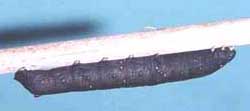 |
Larvae feed on willow weed (Epilobium) and possibly thimbleberry (Rubus parviflorus).
|
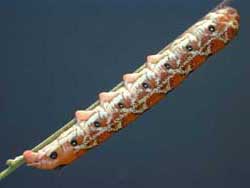 |
Proserpinus juanita Rosebud, Juanita Sphinx:
Newly-hatched caterpillars eat eggshells. (Onagraceae) including evening primrose (Oenothera), gaura (Gaura),
and willow weed (Epilobium). Michael Van Buskirk has found them on Guara biennis in Missouri. rare; usually more northerly
|
|
|
Enjoy some of nature's wonderments, giant silk moth cocoons.
These cocoons are for sale winter and fall. Beautiful Saturniidae moths will emerge the following spring and summer.
Read Actias luna rearing article.
Additional online help available.
Eggs of many North American species are offered during the spring and summer. Occasionally
summer Actias luna and summer Antheraea polyphemus cocoons are available. Shipping to US destinations is done from with in the US.
Use your browser "Back" button to return to the previous page.
This page is brought to you by Bill Oehlke and the
WLSS. Pages are on space rented from Bizland. If you would like
to become a "Patron of the Sphingidae Site", contact Bill.
Please send sightings/images to Bill. I will do my best to respond to requests for identification help.
 | 
Show appreciation for this site by clicking on flashing butterfly to the left.
The link will take you to a page with links to many insect sites. |
This website has been created and is maintained by Bill Oehlke without government or institutional financial assistance. All expenses, ie., text reference
support material, webspace rental from Bizland, computer repairs/replacements, backups systems, software for image adjustments (Adobe Photoshop; L-View),
ftp software, anti-virus protection, scanner, etc. are my own.
I very much appreciate all the many images that have been sent to me, or of which I have been granted permission to copy and post from other websites.
All images on this site remain the property of respective photographers.
If you would like to contribute to the maintenance of this website by sending a contribution to
Bill Oehlke
Box 476
155 Peardon Road
Montague, Prince Edward Island, C0A1R0
Canada
your donation would be much appreciated and would be used for
1) paying for webspace rental;
2) paying for computer maintenance and software upgrades;
3) purchases of additional text reference material (journals and books) in anticipation of expanding the site to a worldwide Sphingidae site;
4) helping to pay my daughter's tuition (completed spring 2013); with anything left over going to humanitarian aid.
If you are mailing a check from USA, please use $1.25 postage. Donations can also be made through Paypal via the button below.




















